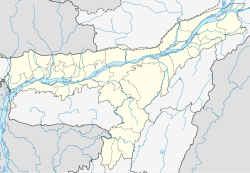Jatinga
|
Jatinga জাতিংগা |
|
|---|---|
| village | |
| Location in Assam, India | |
| Coordinates: 25°06′54″N 92°56′37″E / 25.1149°N 92.9437°ECoordinates: 25°06′54″N 92°56′37″E / 25.1149°N 92.9437°E | |
| Country |
|
| State | Assam |
| District | Dima Hasao |
| Government | |
| • Body | Gram panchayat |
| Languages | |
| • Official | Assamese |
| Time zone | IST (UTC+5:30) |
| Vehicle registration | AS 08- |
Jatinga (Pron: ʤʌˈtɪŋgə or ʤæˈtɪŋgə ), a village on a ridge, is located in Dima Hasao district, Assam State in India. It is 330 kilometres (210 mi) south of Guwahati. It is most famous for the phenomenon of birds "committing suicide". Although the birds do not commit suicide and are actually killed, the myth of the suicides has spread far and wide among common people. The village is inhabited by about 2,500 Khasi-pnar tribal people and few Dimasa people.
At the end of monsoon months especially on moonless and foggy dark nights between 6 p.m. and 9:30 p.m., birds are not disturbed by the locals but out of the dark northern skies will start to descend as they are attracted to lights. These dazed birds are captured using bamboo poles by the locals. The local tribals first took this natural phenomenon to be spirits flying from the sky to terrorize them. This phenomenon is not confined to a single species, with tiger bittern, black bittern, little egret, pond heron, Indian pitta, and kingfishers all being affected, as well as hill partridge, green pigeon, emerald dove, necklaced laughingthrush, black drongo. The birds are mostly juvenile, according to Assam's best known ornithologist, Anwaruddin Choudhury.
The late naturalist E. P. Gee brought this phenomenon to global attention in the 1960s. He drove to Jatinga with famed ornithologist late Salim Ali. The cause of it is likely to be disorientation at high altitudes and high speed winds due to the widespread fog characteristic at the time. The zoological survey of India sent Sudhir Sengupta to unravel this mystery. The most recent description of the phenomenon and its comparison with similar incidents elsewhere in Malaysia, Philippines, and Mizoram is found in the book The Birds of Assam by Anwaruddin Choudhury. He concluded that the birds, mostly juveniles and local migrants, are disturbed by high velocity winds at their roost. When the disturbed birds fly towards lights as refuge they are hit with bamboo poles and killed or injured.
...
Wikipedia


